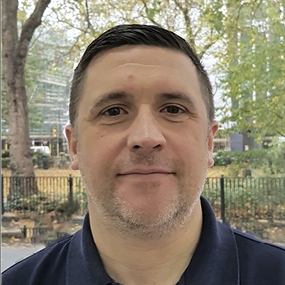Marking LBGT+ History Month: A global symbol for pride

Iain Smart is an AV Engineer at the Royal College of Anaesthetists.
LBGT+ History Month is a chance for our community to share experiences of our struggles and personal achievements. It’s also a time to remember those who we have lost or have sadly fallen along the road in the journey to becoming a defined and accepted group in society.
When I first visited London in 1991, I attended my first Gay Pride with friends. This was the first time I ever saw a rainbow flag. It was a very poignant moment in my life because I realised I was part of a much greater community.
This global symbol has a rich an interesting past. In 1977, following a migration of gay and bisexual men to San Francisco, Harvey Milk won a seat as a City Supervisor. Milk asked army veteran Gilbert Baker and a collective of others to design a flag for the gay and bisexual community. As Milk said, "queer people needed something that was positive, to celebrate our love".
The rainbow design was inspired by Judy Garland's hit song 'Somewhere Over the Rainbow'. Each colour was chosen to symbolise different aspects of life. Hot pink for sex, red for life, orange for healing, yellow for sunlight, green for nature, turquoise for art and magic, indigo for serenity, and violet for spirit. The design was never trademarked; Baker wanted it to be used by all.
When Harvey Milk was assassinated in 1978, the rainbow flag became a sign of support for the community. As demand grew, it became technically difficult to source pink fabric for the flag. In late 1978, Baker decided to remove the pink stripe and take the numbers of colours down to seven to increase production. Turquoise was removed and indigo was replaced with royal blue in 1979, leaving us with the design we are more familiar with today.
Gilbert Baker sadly passed away in his sleep at home in New York on 31 March 2017 at the age of 65. Although his flag became a global symbol representing our diverse community, we cannot be complacent or believe our community has full equality around the world. Many still face bigotry and life-threatening hardships from those who don't understand them or fear them.
We should rejoice our differences and celebrate with others the happiness in our lives. This accelerates greater understanding and acceptance for us all. It helps show others that making the choice to be open and understanding can be a stimulating, rewarding, and defining moment for us.
Equality, diversity, and inclusivity is important to all of us, and the College has now created a staff group to improve, educate and challenge preconceptions. I am very proud that the College is not shying away from the sometimes difficult conversations but is taking a moment to explore and understand ways we can make improvements and redress any wrongs that might be unknowingly in place.
In recent years, the flag has been amended to help recognise the diverse groups that make up the expansive LBGT+ community. In the UK, we all enjoy freedoms and equality, brought to us by different groups through history and we can each play a vital role in keeping these relevant and important stories alive.
Iain Smart
